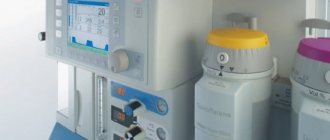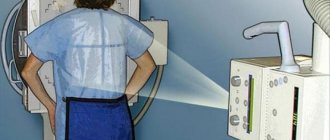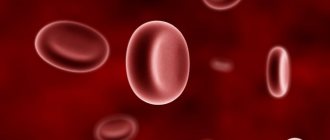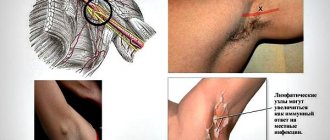The quality of our life depends on many nuances of the state of the body. One of them is the work of our brain. Its excellent functioning is facilitated by healthy blood vessels and the flow of “pure and high-quality” blood into it.
If a failure occurs, there is a need to investigate the cause . One of the methods for identifying the causes of cerebral vascular disease is REG (rheoencephalography).
This article will help you understand and understand the essence of this method.
The essence of the method
The essence of the method is that a current is passed through the human brain ; it is low-frequency and the electrical resistance of the brain, or more precisely its tissues, is immediately shown on the monitor screen.
The method is very simple, brain studies can be carried out for a long time and in any conditions, and the results will be objective in the study of the arterial system of the brain, the venous system and the vessels (large and small) located inside it.
Despite these advantages, many doctors agree that this method has become obsolete (although it continues to be used in many medical institutions), and is replacing it with magnetic resonance and computed tomography or Doppler ultrasound.
The devices used to perform rheoencephalography of cerebral vessels are called rheographs; they have several channels, from 2 to 6, which allows one to obtain results (rheoencephalograms) of several areas of the brain at once.
Most often, round, metal electrodes are used, which are fixed on the human head using tapes made of rubber material in places necessary for research (temples, bridge of the nose, area above the eyebrows, back of the head), and special pastes are used to enhance their contact with the scalp.
The patient, at the request of the doctor, takes various head poses (tilts to the right, left, back, forward), and all the results, which are then used to decipher the readings of the blood vessels in the brain, are recorded. Each age has its own standards of indications.
Reg of the vessels of the head: when to do the examination and how to decipher it?
Z. Nelly Vladimirovna, doctor of the first qualification category, especially for SosudInfo.ru (about the authors)
Everyone knows that the central nervous system regulates all processes in the body, as well as the fact that all its cells also need respiration and nutrients that come through the blood vessels. The quality of life directly depends on the quality of blood supply, taking into account the functions and tasks assigned to our head.
The path of the blood carrying “food” must be smooth and meet only the “green light”. And if in some area there is an obstacle in the form of a narrowing of a vessel, a blockage, or a sharp break in the “road,” then finding out the cause must be immediate and reliable.
In this case, REG of cerebral vessels will be the first step in studying the problem .
Vessels leading to the “center”
When the vessels of our body are smooth and elastic, when the heart provides blood circulation evenly and efficiently, which provides nutrition to the tissues and removes unnecessary substances, we are calm and do not even notice these processes.
However, under the influence of various factors, the vessels may not withstand and “deteriorate.” They cannot adapt to temperature fluctuations and changes in atmospheric pressure, and lose the ability to easily move from one climate zone to another.
The vessels lose the “skills” of quickly responding to the influence of external stimuli, so any excitement or stress can lead to a vascular accident, which rheoencephalography of the brain vessels, taken in a timely manner, will help prevent.
The reasons leading to impaired blood flow are as follows:
- The narrowing of the lumen of blood vessels as a result of the deposition of cholesterol plaques disrupts its elasticity, developing the atherosclerotic process. This often leads to myocardial infarction or stroke;
- Increased formation of blood clots can lead to their separation, migration through the bloodstream and closure of the lumen of the vessel (ischemic stroke).
- Previously suffered traumatic brain injuries, which seem to have ended successfully, can lead to an increase in intracranial pressure, which will also be expressed by manifestations of circulatory disorders.
REG of the brain can determine the presence or absence of a subdural hematoma resulting from traumatic brain injury. The hemorrhage formed in the brain tissue will naturally create an obstacle to the normal flow of blood.
If you don’t get too far ahead, but conduct a study when the symptoms are not clearly expressed and create discomfort from time to time, then the REG of the brain will not only determine the condition of the blood vessels, but will also help you choose tactics to prevent serious consequences that put a person’s life at risk.
In addition, REG shows not only the quality of blood flow through the great vessels, but will also evaluate collateral circulation (when the blood flow through the great vessels is obstructed and it is directed “bypassing”).
Reg and “non-serious” illnesses
There are conditions that, although not fatal, do not allow you to live normally. Now, neurocirculatory dystonia is present in many people, and therefore it is not particularly considered a disease, because “they don’t die from it.”
Or, for example, migraine (hemicrania), considered a whim of society ladies, has safely reached our days and does not leave many women alone.
Headache medications generally do not help unless the medication contains caffeine.
Considering a woman to be absolutely healthy (after all, there are no signs of any illness), those around her often brush it off. And she herself is slowly beginning to consider herself a malingerer, realizing, however, deep down that a head examination would not hurt. Meanwhile, unbearable headaches come monthly and are associated with the menstrual cycle.
A prescribed and performed REG of the head solves the problem in a matter of minutes, and the use of adequate medications relieves the patient of the fear of monthly physiological conditions. But this is a favorable course of the disease, but there is something else...
Few people know that migraine should not be considered frivolous, because not only women suffer from it, and not only at a young age. Men are also sometimes “lucky” in this regard. And the disease can manifest itself to such an extent that a person completely loses his ability to work and needs to be assigned a disability group.
When the need arises to do an REG, patients, as a rule, begin to worry. You can calm down here right away - the method is non-invasive, and therefore painless . The REG procedure does not cause harm to the body and can be performed even in early infancy.
An REG examination of the head is carried out using a 2-6 channel apparatus - a rheograph. Of course, the more channels the device has, the larger the study area will be covered. To solve large problems and record the work of several pools, polyreogreographs are used.
So, the step-by-step REG procedure looks like this:
- The patient is placed comfortably on a soft couch;
- Metal plates (electrodes) are placed on the head, which are previously treated with a special gel to prevent skin irritation;
- The electrodes are attached with a rubber band in the places where it is planned to assess the condition of the vessels.
- Electrodes are applied depending on which part of the brain is subject to REG examination:
- If the doctor is interested in the internal carotid artery basin, then the electrodes will be placed on the bridge of the nose and mastoid process;
- If it concerns the external carotid artery, then the plates will be strengthened in front of the auditory canal and above the eyebrow from the outside (course of the temporal artery);
- Assessment of the functioning of the vessels of the vertebral artery basin involves the application of electrodes to the mastoid (mastoid) process and the occipital protuberances while simultaneously taking an electrocardiogram.
When examining the head with REG, the patient is advised to close his eyes so that external stimuli do not affect the final result. The data obtained by the device is recorded on paper tape.
The obtained REG results, the decoding of which requires additional skills, are sent to a doctor who has undergone special training in this area. However, the patient is very eager to find out what is going on in his vessels and what the graph on the tape means, because, as REG is done, he already has a good idea and can even reassure those waiting in the corridor.
In some cases, to obtain more complete information about the function of blood vessels, tests with drugs that act on the vascular wall (nitroglycerin, caffeine, papaverine, aminophylline, etc.) are used.
What do incomprehensible words mean: decoding REG
When a doctor begins to decipher the REG, he is first of all interested in the patient’s age, which must be taken into account to obtain adequate information.
Of course, the standards for tone and elasticity will be different for a young and an elderly person.
The essence of REG is to record waves that characterize the filling of certain areas of the brain with blood and the reaction of blood vessels to blood filling.
A brief description of the graphical representation of oscillations can be presented as follows:
- The ascending line of the wave (anacrotic) sharply tends upward, its top is slightly rounded;
- Descending (catacrota) goes down smoothly;
- An incisura located in the middle third, followed by a small dicrotic tooth, from where the descending wave descends and a new wave begins.
To decipher the REG, the doctor pays attention to:
- Are the waves regular?
- What is the top and how is it rounded;
- What the components look like (ascending and descending);
- Determines the location of the incisura, dicrotic tooth and the presence of additional waves.
Common types according to REG
After analyzing the rheoencephalography recording, the doctor records the deviation from the norm and makes a conclusion, which the patient strives to quickly read and interpret. The result of the study is to determine the type of vascular behavior:
- The dystonic type is characterized by a constant change in vascular tone, where hypotonicity with reduced pulse filling often predominates, which may be accompanied by difficulty in venous outflow;
- The angiodystonic type differs little from the dystonic type. It is also characterized by disturbances in vascular tone due to a defect in the structure of the vascular wall, leading to a decrease in the elasticity of blood vessels and complicating blood circulation in a certain pool;
- The hypertensive type according to REG is somewhat different in this regard; here there is a persistent increase in the tone of the afferent vessels with obstructed venous outflow.
Types of REG cannot be classified as separate diseases, because they only accompany another pathology and serve as a diagnostic guide for determining it.
The difference between REG and other brain studies
Often, when signing up for an REG head examination at medical centers, patients confuse it with other studies that contain the words “electro,” “graphy,” and “encephalo” in their names. This is understandable, all the designations are similar and sometimes it is difficult for people who are far from this terminology to understand.
Electroencephalography (EEG) is especially useful in this regard. That’s right, both study the head by applying electrodes and recording data on the work of some area of the head on a paper tape.
The differences between REG and EEG are that the first studies the state of blood flow, and the second reveals the activity of neurons in some part of the brain.
Vessels have an indirect effect during EEG, but long-term circulatory disorders will be reflected in the encephalogram. Increased convulsive readiness or other pathological focus on the EEG is clearly detected, which serves for the diagnosis of epilepsy and convulsive syndromes associated with trauma and neuroinfection.
Where, how and how much does it cost?
Undoubtedly, where it is better to undergo an REG of the brain, the price of which ranges from 1000 to 3500 rubles , the patient decides. However, it is highly advisable to give preference to well-equipped specialized centers. In addition, the presence of several specialists in this profile will help to sort out difficult situations collectively.
The price of REG, in addition to the level of the clinic and the qualifications of specialists, may depend on the need for functional tests and the impossibility of carrying out the procedure in the institution. Many clinics provide this service and visit your home to conduct the study. Then the cost increases to 10,000-12,000 rubles .
Display all posts with the tag:
- Surveys
- Encephalography
Source: https://sosudinfo.ru/golova-i-mozg/reg-sosudov-golovy/
What REG shows and explores
Let's decide what the REG of the brain shows.
The results of the REG provide extensive information about the state of the blood vessels in the brain .
Based on the indicators, the specialist studies the tone of the vessels, the elasticity of their walls , how quickly blood flows into them, how they behave under different loads (tilting and turning the head), and, accordingly, the outflow of blood from the head.
The results may be the identification of cholesterol growths on the walls of blood vessels, or hematomas , after suffering injuries to the skull, a predisposition to the formation of blood clots inside them, and the development of intracranial pressure.
You can find out what an ultrasound scan of cerebral vessels shows and what indications for the procedure exist from our study.
There are specific signs of stroke in men that differ from those in women. Knowledge of which can save the patient's life.
Obtained results
Many patients ask their doctor a question when identifying a hypertensive type of REG, what is it? In order to get an answer, it is necessary to consider the main options for disturbances in the tone of venous and arterial vessels, which are detected using rheoencephalography.
There are several types of vascular tone patterns with EEG:
- dystonic waves that occur in cases where the outflow of blood through the veins is impaired, however, vascular tone is reduced and pulse filling is weak;
- angiodystonic waves occur during pathological processes in the wall of the vascular bed. Such changes lead to the fact that the elasticity of the arteries is significantly reduced, which is characterized by difficulty in blood flow through them and the appearance of a characteristic type of rheoencephalogram;
- the hypertonic type of waves is characteristic of vessels in which there is increased blood pressure (hypertension) with a simultaneous disruption of the outflow of blood through the veins.
One REG study is not enough to make a diagnosis. The doctor should take into account both the clinical picture of the disease and data from other laboratory and instrumental studies.
Functional diagnostic doctors decipher REG results
Indications for the study
When our body as a whole works evenly, there are no special instructions in the study of its work.
But external factors (temperature changes, pressure fluctuations in the atmosphere, movement from one climate zone to another) often interfere with the activities of our body, thereby affecting it and its components.
Vessels are no exception. They wear out, do not withstand impact, and malfunctions occur under stress or anxiety. REG allows us to identify them.
The following main indications for REG of the brain are distinguished:
- Cholesterol formations on the walls of blood vessels impair their elasticity, and the patient develops an atherosclerotic process, which in most cases leads to myocardial infarction or stroke. (REG is prescribed in case of a stroke or heart attack. If the patient is hypertensive or has been diagnosed with a disease - vegetative-vascular dystonia).
- Predisposition or formation of blood clots , with their further separation and blockage of the vessel leads to ischemic stroke (with cerebral ischemia or if there are symptoms of its development).
- Head injuries suffered for no apparent reason (pain, dizziness) lead to the appearance of intracranial pressure or hemorrhage in the brain tissue (with a concussion or bruise).
- Headaches, migraines , are a consequence of improper blood flow in the vessels of the head (with headaches, tinnitus, disturbances of the vestibular apparatus).
- For insomnia, decreased vision, fainting.
Indications for the diagnosis of REG of cerebral vessels
A diagnostic measure is indicated in cases where the patient has the following complaints:
- Increased weather sensitivity;
- Frequent migraines;
- Insomnia;
- Fainting conditions;
- Deterioration or loss of memory;
- Noise in ears;
- Loss of orientation due to a sudden change in body position.
Familiarize yourself with the features of the manifestation of ischemic - /mozg/ishemicheskij-insult.html and hemorrhagic stroke - /mozg/gemorragicheskij-insult.html.
The procedure is recommended for persons whose close relatives have been diagnosed with cerebrovascular diseases.
REG of the brain may also be prescribed as an additional study after MRI.
Carrying out rheoencephalography in children is more preferable than a tomography procedure: in the latter case, placement in a machine is required and the need for a long period of time in a supine position. For REG, the child must take a sitting or lying position and wait for some time, without being left alone, as is the case when placed inside the tomograph.
REG of the head is recommended for elderly people to prevent the development of vascular diseases, since with age the arteries lose their elasticity and cannot function fully.
In addition to being non-invasive, this diagnostic procedure has the advantage of having no contraindications. A relative prohibition is the neonatal period. This is due to the fact that at this age the amplitude of the waves is small, and this significantly reduces the effectiveness of the study.
Also, REG is not performed if the skin on which the device’s electrodes need to be applied is damaged by mechanical action, as well as in case of bacterial, fungal or parasitic diseases that have spread to these areas.
Advantages of the study compared to other methods
Many doctors on medical forums dispute the ignoring of REG and its replacement with more modern research methods.
Those who are against it argue that the bones of the skull are not capable of conducting sufficient current (there is resistance), and the results of the study of internal vessels are not accurate, all indicators show only the condition of nearby vessels.
To refute this, there are articles by medical scientists stating that the bones of the skull are not an obstacle due to their predominantly capacitive reactance.
The advantage of this method is that it cannot be influenced by external factors (tissues of the human body, signal amplitude, wave propagation), while other methods are susceptible to these phenomena.
Distinctive features
Experts talk about which diagnostic method to choose, eeg and reg, and which method is better. The characteristics of the study are similar to each other. But, they have certain differences. The use of REG is recommended for studying the state of the vascular bed . Using manipulation, the elasticity and strength of blood vessels is determined. The use of diagnostics is recommended for suspected dystonia, hypertension, or vascular dysfunction.
An EEG is designed to record brain activity. This is a highly informative technique that captures outgoing biocurrents. When using the examination, pathological changes in the brain are determined. It is used for frequent fainting and convulsions in the patient, and sleep disturbances. The use of the examination method is recommended for developmental delays and neoplasms in the brain.
Electroencephalography is used to determine the localization of inflammatory processes and detect functional disorders. This manipulation is used to diagnose epilepsy. It provides the ability to determine the sites of seizure origin.
The examination is recommended to be carried out to determine the characteristics of the disease and the effectiveness of the therapy used. If there is a need to resolve the issue of professional suitability, then the use of EEG is recommended.
Roencephalography and electroencephalography are diagnostic measures that are used for diseases of the brain. With the help of the first of them, the determination of functional disorders of the organ is ensured, and the second - the state of blood supply to the organ. The prescription of a specific research method should be carried out by a doctor in accordance with the indications, which will provide the opportunity to develop an effective treatment regimen.
Research process
The process of conducting research using rheoencephalography of cerebral vessels is simple. The only condition is calm.
The patient lies on his back with his eyes closed on honey. sofa. The doctor degreases the areas of the head to be examined with alcohol and places metal electrodes on them, which are lubricated with contact paste to improve sensitivity.
The electrodes are secured using rubber bands. A weak current is passed through the electrodes, with the help of which the indicators of the brain vessels are recorded. “Curved lines” appear on the monitor screen - indicators of the functioning of blood vessels and blood flow.
Preparation for the procedure
Preparation for the procedure takes about 5 minutes. The specialist degreases the patient's areas of interest and attaches metal electrodes to them.
The process has started
The technique is safe and painless.
Since a 15-minute break or rest is recommended , in total it takes the patient about 25-30 minutes (this time also includes the preparatory process).
It is recommended not to smoke 2-3 hours before the start of the procedure, and not to take any medications that affect blood circulation in the body the day before. It is carried out in a lying or sitting position.
REG and children
During the examination, the child is asked to sit or lie still, with his eyes closed. Since the study can last at least half an hour, this can be difficult for a restless child. In order to prepare your baby for the procedure, you need to try to tell him why it is necessary, explain how important it is. You can reach an agreement with your child in a playful format.
It must be said that for children, REG is easier than magnetic resonance imaging.
After all, here he sits or lies surrounded by adults. During the tomography he will have to be separated from everyone else, inside a machine that produces different sounds.
Results and transcript
The specialist displays the REG result on paper, which shows curved lines, and begins to decipher them.
The first thing to pay attention to is the age of the patient; each age (young and old) has its own standards for REG readings.
Curved lines are oscillations of waves, which are characterized by the behavior of blood vessels on the filling with blood and the filling of individual parts of the brain itself. Waves are represented by lines going up (anacrota) and down (katacrota).
On the downward line there is a dicrotic tooth. The incisura is located in the middle third, in front of the dicrotic tooth.
When deciphering the results of rheoencephalography of cerebral vessels, attention is paid to the regularity of the waves, their apex and its rounding, ascending and descending lines, the presence of other lines, the location of the incisura and dicrotic tooth.
What is rheography
Rheography is an assessment of the rheological properties of blood, that is, its ability to pass unhindered through the vessels. In this case, the vessel wall and the blood itself are assessed. The method is carried out using electric current. Its basis is the different conductivity of current between blood and body tissues. When current passes through tissue and blood, this difference is read by the device's sensors and recorded on a special tape, as with an electrocardiogram. The resulting line is called a rheoencephalogram. Only a specialist deciphers it, making a conclusion about the state of hemodynamics in the brain.
Reviews from patients and doctors
Doctors' opinions differ due to their age. Young specialists put forward their opinions for the use of new methods (computer, ultrasound) research, older specialists adhere to REG.
But there are no negative reviews and calls not to use this technique. The patients are happy.
This is especially true for mothers with small children, who can be sat on their laps, where the child feels safe, or for pensioners, who, in preparation for the procedure, can lie down and talk with the doctor during the diagnostic process.
What is REG (rheoencephalography) of the brain: normal indicators and interpretation of results
- blood viscosity
- pulse wave velocity
- blood flow speed
- severity of vascular reaction
Research procedure
- The subject sits in a chair or lies on his back and closes his eyes.
- The doctor, having degreased the necessary areas of the head, places electrodes on them, fixing them with rubber bands. Electrodes are not placed in a random order, but on the exact area of the skull whose vessels are to be studied. To monitor the condition of the artery of the spinal column, electrodes are placed on the back of the head. They are attached to the temporal region when working with the external carotid arteries, and to control the internal ones - to the bridge of the nose and mastoid processes.
- A small electric current is supplied to the electrodes, which records the various states of the blood vessels in the brain.
- All indicators of vascular activity are displayed graphically on the monitor screen.
Important. To complete the picture of the condition of the blood vessels, REG is used in conjunction with other studies, for example, ultrasound, EEG.
This is how the traditional REG procedure is performed. An option is to conduct a study using functional tests. The patient is asked to perform the following actions: turn his head, tilt his head, hold his breath, perform any physical activity. Data from standard and functional procedures are recorded and carefully compared by the physician.
- the shape of the graph vertices is round or pointed;
- how regular the waves are;
- location of the incineration;
- what anacrota and catacrota look like;
- are there any additional waves;
- amplitude and steepness or flatness of teeth.
Cost of the procedure
The price of REG of cerebral vessels ranges from 1000 to 3500 rubles. Where to undergo the study and for what amount is chosen by the patient himself.
It is worth noting that it is better to do this in specialized centers equipped with modern equipment and with the presence of several specialists who, together, can make an accurate diagnosis in difficult cases and prescribe treatment.
Many clinics offer their services to carry out this procedure at the patient’s home, then the cost increases to an amount from 10,000 rubles to 12,000 rubles.
Lifestyle and vascular condition
The lifestyle of each of us can have both positive and negative effects on vascular health. Harm brings:
- Hypercholesterolemia. Consumption of fatty and fried foods increases the amount of cholesterol in the blood, which increases the likelihood of atherosclerosis.
Poor nutrition is a risk factor for atherosclerosis
- Stress is a person’s defensive reaction to danger, working according to the “fight or flight” scheme. During a threat, an adrenaline surge occurs, a large number of neurotransmitters are released, which depletes the body's reserves and has a bad effect on blood vessels.
- Smoking. The body of a smoker produces a large number of free radicals that can damage the vascular endothelium.
The body also experiences oxidative stress during inflammatory processes, prolonged exposure to the sun, and even overeating.
Thus, REG of cerebral vessels still remains a popular research method among specialists, which can bring valuable information to the doctor. The main thing is not to try to decipher the results yourself, but to trust your doctor in this regard.
And so that this procedure is not required for a long time, you need to take care of your health and adhere to a healthy lifestyle.
Medical centers conducting research
Medical centers offer their services
- "Doctor Plus", Moscow. bolezni-spravka.ru;
- "University Clinic", St. Petersburg;
- "University Headache Clinic", Moscow. https://es.foursquare.com;
- "Doctor DoStaLet", Moscow.
REG is a very effective method for diagnosing the condition of cerebral vessels.
Despite the widespread use of modern techniques, REG continues to be used in popularity both among doctors and patients.
This is due to the availability of the procedure and the prevalence of devices in the country.
The almost complete absence of contraindications or side effects convinces many doctors to use this particular diagnostic method.
Benefits of Electroencephalography
When using EEG, doctors perform the following actions:
- evaluate epileptic seizures according to their classification;
- identify areas of the brain where seizures occur;
- track the dynamics of the effects of drugs on the activity of the human brain;
- give answers about a person’s professional suitability, because the presence of epilepsy will become an obstacle for a person to get a job that involves driving vehicles and requires perseverance and concentration.
Electroencephalography is prescribed to patients who have a predisposition to epilepsy, diseases of the cardiovascular system, persistent headaches, and disorders of the nervous system.
To get the desired effect from the study, the patient is placed in a chamber. To identify hidden epilepsy, brighten the room and increase the noise effect inside the room. The patient is put into a sleep state and then woken up after some time. Frequently turning on and off the light affects the human nervous system, thus trying to awaken latent epilepsy, if any. The duration of one procedure is at least 45 minutes. In especially severe cases, this procedure reaches 120 minutes. After undergoing an EEG, the patient returns to his normal daily routine.
On the eve of the EEG, get a good night's sleep and gain strength for the diagnosis. Before starting the procedure, the person should be at rest for about 20 minutes. In this case, high-quality results are obtained.
EEG causes a stressful situation in a person. Therefore, if a child is the object being studied, so that he is not afraid of her, a conversation is first held with him, during which the upcoming procedure will be described to him.
Features of EEG
Electroencephalography is an effective diagnostic method that thoroughly examines the brain. An examination is recommended for: degenerative organ damage, epilepsy, vascular diseases, dysontogenetic diseases, head injury, inflammatory processes, psychiatric pathologies, tumor processes.
If a patient has hereditary diseases of the central nervous system, then this diagnostic method is recommended. It is used for encephalopathies, regardless of their genesis, as well as functional disorders of the brain.
The use of the method is recommended to distinguish between epileptic and non-epileptic seizures. During the examination, the affected areas of the brain are determined. EEG is recommended to monitor the dynamics of drug treatment. Diagnostic manipulation provides an opportunity to resolve the issue of professional suitability.
Electroencephalography (EEG)
Electroencephalography (EEG) is an accessible and safe method of studying the brain by recording brain biocurrents.
Neurons - the main elements of the central nervous system (and the brain, including) - are capable of generating and conducting electrical impulses that are recorded by an electroencephalograph. This method is of great importance for the early detection of injuries, tumors, vascular and inflammatory diseases of the brain, and epilepsy. In addition, this is the only neurological outpatient study that is performed during attacks of loss of consciousness.
In our clinic, electroencephalography is performed by highly qualified neurologists-neurophysiologists with extensive practical experience in working with patients of various age groups.
1 Electroencephalography (EEG)
2 Electroencephalography (EEG)
3 Electroencephalography (EEG)
EEG is absolutely harmless, has no contraindications, and therefore is used for patients of any age, both children and the elderly.
Electroencephalography is a highly informative study that reflects the functional state of the cortex, subcortical structures of the brain, as well as complex cortical-subcortical interactions, including the hidden pathology of diseases that have not yet manifested against the background of the complete clinical health of the subject.
EEG allows you to monitor the course of the disease over time, adjust treatment if necessary, and evaluate the effect of drug therapy (overdose or withdrawal of antipsychotics, tranquilizers, barbiturates, antidepressants) on brain activity. Unlike CT and MRI studies, EEG reveals structural and functional (reversible) changes that persist for a long time in the brain, for example, after a mild traumatic brain injury.
The role of EEG in the diagnosis of epilepsy
EEG is the most important diagnostic method for epilepsy. Every year, from 20 to 120,000 new cases of epilepsy are registered per year (on average - 70 - 100,000). In the CIS countries alone, about 2.5 million people suffer from this disease. Epilepsy is often combined with other diseases, such as cerebral palsy, chromosomal syndromes, and hereditary metabolic diseases. The incidence of epilepsy, for example, in patients with cerebral palsy is up to 33%.
An experienced neurologist/neurophysiologist can confirm the diagnosis of epilepsy based on the results of an EEG. In addition, diseases that occur without clinical manifestations have recently become widespread, but are characterized by pathological activity in the brain that significantly impairs its functioning (for example, epileptic encephalopathies). In such cases, EEG is the leading research method.
Electroencephalography technique
EEG is completely harmless and painless. During the examination, the patient sits comfortably in a chair. Using a special helmet, small electrodes are attached to his head, connected by wires to an electroencephalograph. The device amplifies the biopotentials received from the sensors hundreds of thousands of times and records them in the computer memory.
1 Electroencephalography (EEG) in MedicCity
2 Electroencephalography (EEG) in MedicCity
3 Electroencephalography (EEG) in MedicCity
No special preparation is required to conduct an EEG, but there are several recommendations. It is important that the patient is not hungry during the examination, as this may cause changes in the EEG. And you should wash your hair the day before the test - this will allow for better contact of the electrodes with the scalp and, accordingly, the results will be more reliable. You should not give up your usual medication intake, as this can provoke seizures and even epistatus. The interpretation of EEG results may depend on the patient’s age, medications he is taking, the presence of tremor of the head and limbs, visual impairment, skull defects, etc.
1 Electroencephalography (EEG) in MedicCity
2 Electroencephalography (EEG) in MedicCity
3 Electroencephalography (EEG) in MedicCity
Diagnostic capabilities of EEG
With EEG you can:
- distinguish epileptic seizures from non-epileptic ones and classify them;
- identify areas of the brain responsible for triggering seizures;
- track the dynamics of the action of drugs;
- assess the functional state of the brain (even in the absence of changes on a CT scan of the brain);
- resolve the issue of professional suitability (the detection of epileptiform phenomena serves as the basis for the selection of professions related to driving, requiring constant attention and quick response to sudden situations and stimuli in conditions of increased risk).
Indications for EEG:
- epilepsy and other types of paroxysms;
- brain tumors;
- traumatic brain injuries;
- vascular diseases;
- inflammatory diseases;
- degenerative brain lesions;
- headache;
- dysontogenetic diseases;
- hereditary diseases of the central nervous system;
- functional disorders of nervous activity (neuroses, neurasthenia, obsessive movement neurosis, somnambulism, etc.)
- psychiatric pathology;
- encephalopathy of various origins (vascular, post-traumatic, toxic);
- post-resuscitation conditions due to somatic pathology.
Our clinic uses the latest biofeedback-EEG training technique, which includes taking an electroencephalogram, which records the main rhythms of the brain (alpha, beta, delta, tetarhythms). An EEG (electroencephalogram) assessment is carried out by an experienced neurologist-neurophysiologist, and a conclusion is given about the characteristics of brain rhythms and the distribution of biopotentials in various areas of the cerebral cortex. Depending on the indications, the necessary course of biofeedback-EEG training is selected (relaxing, activating, etc.).











